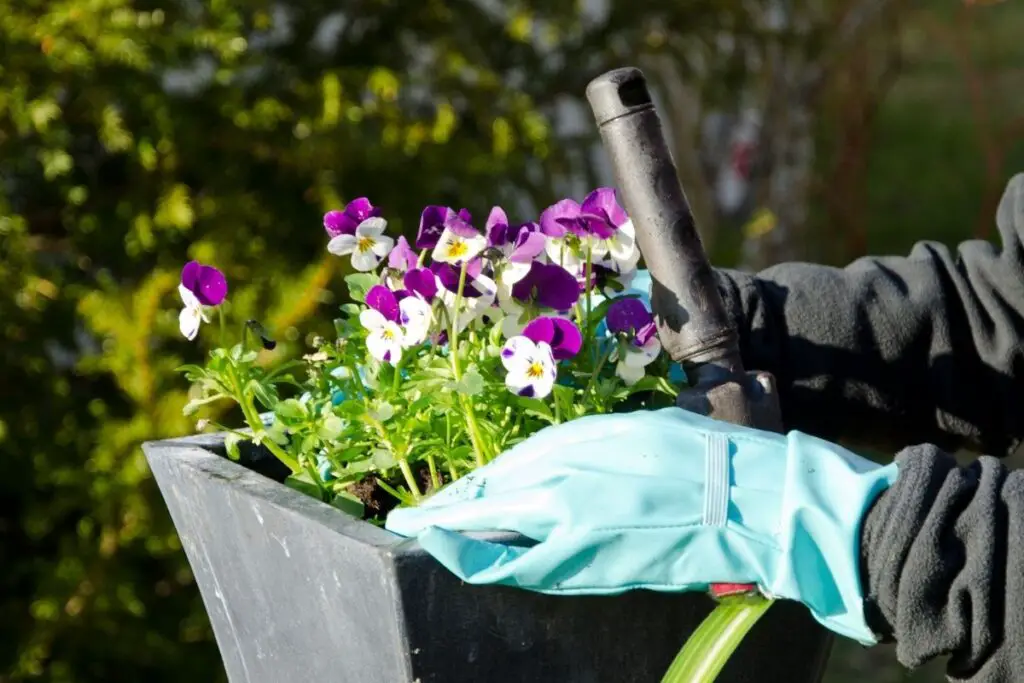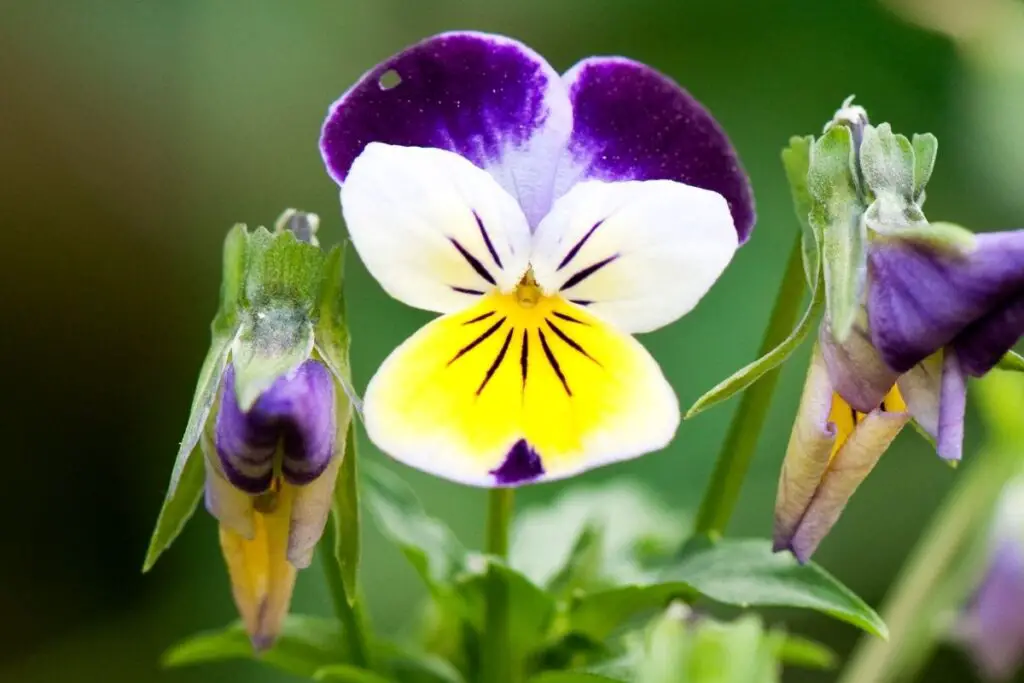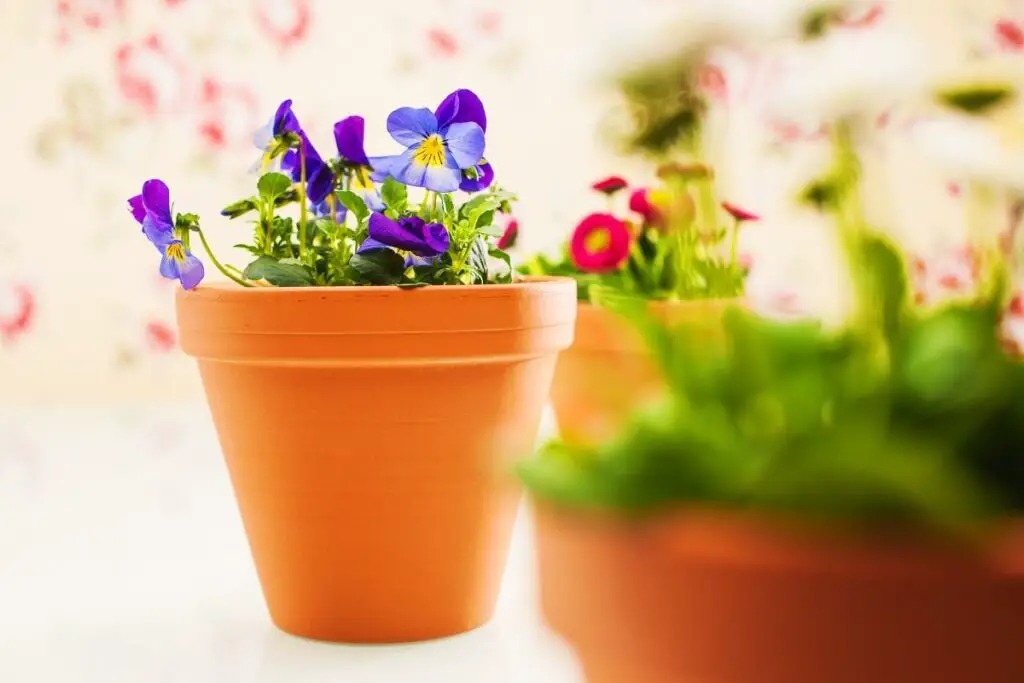Every flowering plant has a life cycle, and pansies are no exception. The lifespan of a pansy plant depends mainly on the temperatures of its growing zone. The pansies life cycle may be a fleeting few months or from one spring to another. Let’s find out what to do with the pansies at the end of the season.
In general, pansies plants need to be replaced with something else after the plant is done blooming or the plant started wilting. Pansies are usually classified as annuals or biennials, as they are mainly grown for one season. But in some regions pansies can be grown as perennials.
Pansies do best in cooler temperatures, but whether you can keep and grow them in summer or winter depends on the place where you live, your climate, and the variety of pansies you choose.
This article will discuss the preparations you can make for pansies at the end of their growing season.

The life cycle of pansies
Pansies, like other flowering plants, follow a fundamental behavior in their life cycle. The pansy is of three types :
- Annuals
- Biennials
- Perennials
Annuals
Annuals are those plants that are grown for one season. The purchased plants are treated as annuals since they already have flowers. These plants are primarily hybrids that grow for one season and then die off.
Biennials
Pansies are also known as biennials. They grow leaves in the first year and flowers in the second since they might not survive harsh winters and summers, and thus they end their life cycle after two years. So, they are known as biennials.
Looking for gardening supplies? We have tested 100's of products before recommending them to you guys. Check out our best pick below:
| Image | Gardening Supplies | Best Price? |
|---|---|---|
 Top
Top Top
Top | Raised Garden Bed Kit | Check On Amazon |
 | XLUX Soil Moisture Meter, Plant Water Monitor, Soil Hygrometer Sensor for Gardening, Farming, Indoor and Outdoor Plants, No Batteries Required | No Results |
 Top
Top Top
Top | 82 Pcs Garden Tools Set and Extra Succulent Tools Set | Check On Amazon |
 | Joeys Garden Expandable Garden Hose with 8 Function Hose Nozzle, Lightweight Anti-Kink Flexible Garden Hoses, Extra Strength Fabric with Double Latex Core, (50 FT, Black) | No Results |
 Top
Top Top
Top | Dual Chamber Compost Tumbler | Check On Amazon |
 Top
Top Top
Top | Sunnyglade Plant Stakes | Check On Amazon |
 Top
Top Top
Top | Organic Cold Pressed Neem Seed Oil | Check On Amazon |
 Top
Top Top
Top | Mighty Mint Gallon :-Insect and Pest Control Peppermint Oil | Check On Amazon |
 Top
Top Top
Top | Scotts DiseaseEx Lawn Fungicide | Check On Amazon |
 Top
Top Top
Top | Jacks Classic 20-20-20 All Purpose Fertilizer | Check On Amazon |
 Top
Top Top
Top | 30,000 Seeds Pollinator Attracting Wildflower Mixture | Check On Amazon |
 Top
Top Top
Top | Survival Vegetable Seeds Garden Kit-Over 16,000 Seeds | Check On Amazon |
Perennials
Pansies are considered short-lived perennials. But in a true sense, they cannot come year after year.
They will mostly grow seeds, drop their seeds, and those seeds will grow in the next year. And this process continues, so they are termed perennials.
Do pansies grow back every year?
Pansies are considered short-lived perennials. They don’t come back every year just like a typical perennial
However, in some regions pansies act like perennials, because they are self-propagating by reseeding themselves annuals or biennials. In case of extremely low temperatures, most of them will die in winters.
But in places with moderate temperatures, they may come back in the next season if you had mulched the soil to protect their roots.
Pansies come back the following year in cool and wet places, or their seedlings can provide year after year of colors.
They are treated as perennials only in places with short freezes, cool summers, and moderate temperatures. These plants are highly influenced by temperatures, both hot and too cold temperatures can kill them.
Even in areas where these plants are treated as perennials, they are short-lived. They can only survive for a couple of years.
Also read: Are Pansies Perennials? (+How To Grow Pansy As Penerrials)
Can you keep pansies in the summer?
They are classic cool-weather plants.
Pansies generally do not bloom in heat, they will bloom until the beginning of summer, and then they will wilt and sag and stop blooming. But you can keep them flowering again in the fall as temperatures cool off.
Some varieties of pansies are heat tolerant, but it is still difficult for them to survive in extremely hot weather.
Pansies will struggle with temperatures that go over 70°F. But you can grow pansies and get them to bloom in summers in the areas that have cool climates and are below 70°F.
Also read: How To Keep Pansies Alive In Summer?
Can you keep pansies in winters?
Pansies are hardy plants that can survive frost. If planted in fall, they will return with charming colors in spring. In some places, they can bloom through the winter months.
Some cold-tolerant varieties can survive and bloom in winters.
You can keep growing pansies in winter by putting them in full sun and protecting their roots with straws or branches.
You can plant them in containers or hanging baskets, but be sure to transplant them into the ground afterward.
Also read: Can Pansy Survive Winter? (Ideal Temperature+Care)
Can you keep pansies all year around?
Pansies can be grown all year round. Many varieties of pansies with a wide range of growing requirements are available, making it easy to grow pansies year-round.
In warmer and moderate climates, they can be grown year-round.
Pansies come in different types. Some pansies, such as the Viola hybrid, grow well in cool temperatures. Others like Imperial Antique shade perform well in hot climates.
Some varieties prefer full sun, whereas other varieties like pansy violets do best in the shade. Some grow well in rich soil, while others like rocky soil.
Most pansies are spring bloomers, while some varieties like Viola heimalis grace autumn and winter gardens with fresh blooms. So you can grow them all year round.
When is the end of the growing season for pansies?

Pansies can survive for one growing season or two years when they are biennials. Once the two-year growing cycle is complete, they die back completely.
Pansies grow and bloom during the cool fall, winters, and spring months when temperatures remain above freezing. When the summer temperatures rise, the heat-sensitive pansies wither and die.
Pansies can last up to eight months, i.e., from September to April or May, which sums up their one growing season.
What to do with pansies after their flowering season ends?
One major question is what we should do with the pansies after their flowering season ends.
Pansies are some of the first blooming flowers in early spring. They bloom until summer and become dormant with the temperature rise.
There are four major initiatives that you can take when your plants’ flowering season ends. The four initiatives are:
- Preparing pansies to bloom again
- Replacing dying pansy plants
- Establishing pansies from seeds
- Positioning pansy flowers
Let’s discuss these points in detail.
Preparing pansies to bloom again

You can make preparations for your pansies during spring so that they can bloom again in the fall when the temperature drops.
After flowering, the blooms fade, and pansies start producing seeds. So to make your pansies bloom again, you need to pinch off the seed pods before they fully develop.
The seeds stay dormant until the following spring. You have to remove the spent flowers from the plant and cut back any extra growth.
For that, you have to keep an eye on your plant. You can check your pansies regularly, as often as twice a week, for any spent flowers and remove them.
Deadheading spent blooms is necessary as this will give space for the new blooms to grow. Removing dead blooms will encourage the plant to utilize its energy toward developing new growth and blooms.
Be careful while removing damaged and dead blooms. Never cause any damage to the rest of the plant.
You have to take care of your plant so that they can bloom again. For that, you have to follow specific care tips, such as:
- You should keep the soil moist but not soggy, as pansies love moist soil.
- You should do regular watering to avoid the soil getting too dry.
- Apply phosphorus fertilizers instead of nitrogen fertilizers as pansies can’t tolerate high levels of nitrogen.
- Always trim off leggy stems and uncontrolled growth from the plant as the areas with uncontrolled growth will mainly produce fewer blooms.
- Remove all the seed pods that you missed during the flowering season.
Replacing dying pansy plants
After the flowering season ends, you can replace the pansy plants that died back or stop producing flowers with new pansy plants.
Some places have year-round pansy growth, whereas some areas don’t. As a result, pansies are mainly grown as annuals or biennials but not perennials.
You can buy new pansies from the nursery. Make sure to buy plants that have healthy green leaves and stems. Choose busy, stocky pansies with plenty of buds.
You should not buy those pansies with open blooms as they are already stressed from growing in a small pot. These plants will never do well when planted.
Establishing pansies from seeds
You can grow the seeds from dead pansies to establish your pansy plant indoors.
Your seeds require a temperature of around 60°F during their germination. The seeds need darkness for germination. For that, you can cover the soil with black plastic.
Germination of seeds needs some care and effort, and you have to check the soil daily and water if necessary to avoid it from drying out.
Remove the plastic from the seed tray once you notice the first shoots of your plant. The seeds will take some time for germinating.
The seeds can germinate in one to two weeks. It can also take about 15 weeks before the pansy blooms. You have to establish and grow the seeds indoors four-six weeks before the beginning of the fall.
When the temperature gets warm, you can transplant the established seedlings outdoor.
You could try many varieties, such as Bolero pansies, which do well in the spring and fall months. They are large and have semi-double flowers.
Joker pansies are most preferred as their blooms are contemporary bicolor. Freefall pansies are great for containers and hanging baskets.
Or, you can go to princess pansies that have monochromatic blooms available in different colors.
Bingo pansies are available in many colors ranging from light blue to burgundy. You can also consider Fama pansies which flower during winter and springtime and are available in different colors.
Positioning pansy flowers
If you are growing new pansies, you should plant them in an area with full sun to partial shade. Although the plants require full sun for their growth, they also thrive in some partial shade that will keep them blooming for an extended period.
The planted area should receive morning sun but sometimes should get a shield in case of extreme heat. It would help if you spaced the pansy plants and did not cloud them altogether, as spacing will encourage good air circulation between them.
The ideal spacing is 7 to 12 inches apart, sufficient for them since they grow 9 to 12 inches wide. The height of pansies is about 6 to 9 inches tall. These dimensions are also helpful for establishing pansies in containers.
Pansies are not fussy plants, and they can grow in almost any kind of soil. However, they perform best in slightly acidic soil with a pH value of 6.0-6.2 on the pH scale.
The soil should be rich and loose that ensuring drainage. As earlier noted, they don’t like heat and begin to decline as temperatures rise.
So these were the initiatives that you can take at the end of pansies flowering season.
Also read: How To Make Pansies Bloom More?
Ref: The University of Arkansas, Britannica, Utah State University, Wikipedia, The University of Georgia, The Pennsylvania State University, The Royal Horticultural Society.
